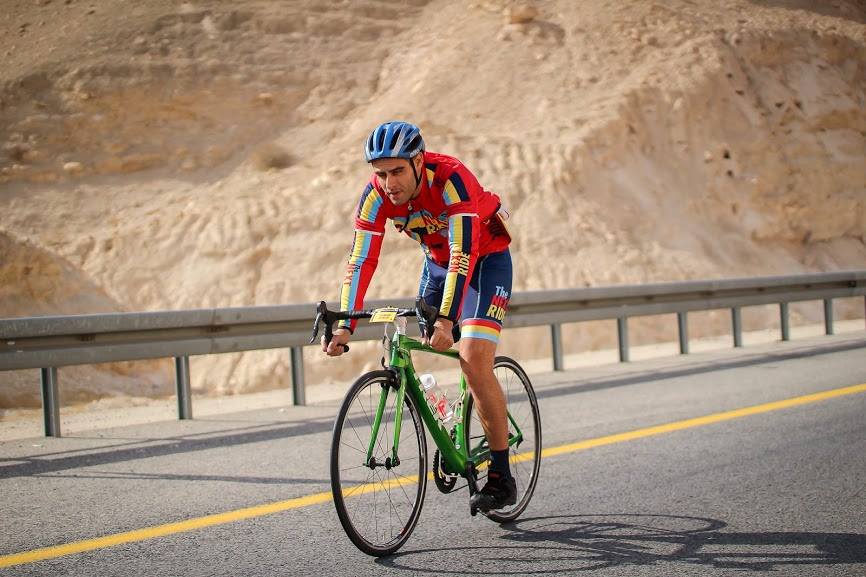Not Backing Down: The Determined Amputees
Struggling between pain and hope, they face remarks like "Some run with crutches, why make a fuss?" while enduring pitying looks convinced it's the end of the world. A story of the amputee community in Israel funded by an American Jew.
 Photo: David Feldman
Photo: David FeldmanWhen Itamar Shanaf awoke after the accident, he didn’t immediately realize where he was. "I saw people in white robes, tubes coming from my mouth, then recognized the hospital," he recounts. "There's this movie cliché where someone wakes up in the hospital and moves their fingers and toes – it really was like that. You open your eyes and try to understand what's happening with your body. I had a strange feeling all over but mostly in my right leg. I felt the leg but couldn’t really move it."
Unable to move from his bed, Itamar began signaling to people with his hand, pointing to his leg to ask what happened. "People stood awkwardly, not knowing what to say. I realized something was up. My army friend and my dad came in, and I must have dozed off again. Other friends entered the room, and then Dr. Pfizer, an excellent physician now head of the orthopedic department at Shaare Zedek, calmly informed me that I had lost my leg. But he assured me, 'You'll get through this.' I wasn't scared, just surprised he knew everything would be okay. Yet, I felt calm and believed it truly would be okay. I thought I made a huge mistake, but I'm here and will do whatever it takes to get through it and just live my life."
Like a Freed Prisoner
It was ten years ago. Itamar Shanaf, then 28, was riding a scooter one evening in Jerusalem. While descending near the Supreme Court and continuing with the road to the left, the accident happened. He doesn’t recall the event, but it was explained that he crashed, his leg got stuck between the curb and the scooter, and was torn from the body on the street. The other leg also suffered a severe blow, its bone shattered.
After waking in the ER, he initially focused on dealing with the pain. "In those stages, awareness is limited. You're on a lot of painkillers, not thinking much, mostly sleeping, dealing with pain. Pain occupies your attention – you're preoccupied with how to get through it, not with the future. At least that was my experience," he recalls. Later transferred to a ward, he was hooked up to a machine sucking infection from the stump. That period stands out as the toughest part of dealing with the injury. "It was truly a nightmare. The sensation is like the leg is bent, you’re lying on it, driving you insane. Those were tough six weeks lying with general pain and phantom pain in the leg."
After six weeks, Itamar was disconnected from the machine and discharged for the first time since the injury, heading to rehabilitation at Hadassah Mount Scopus. Leaving the hospital filled him with elation. "The initial exit from the hospital gates felt liberating, like being released into the world. Like a freed prisoner. On the first day of rehab, they taught me to walk with crutches, a huge relief amidst the chaos. I was thrilled to move independently, no longer bound to a bed. Independence is crucial for me. Suddenly, I could go places, navigate the hospital corridors in a wheelchair." He was the youngest in rehab. "Being in hospital offers little privacy, limited activities. To this day, I remember the book I read there as the best of my life."
After two months of rehab, Itamar rented an apartment in Kiryat Yovel. "During that period, I was in a wheelchair due to the shattered other leg. A metal rod inserted post-accident broke, requiring surgery. During those days, I met my wife Rachel. We married and now have two children."
Was the injury an issue for her?
"For me, it wasn’t an issue, and what you project is what others perceive. Research backs this up. People around can’t know whether losing a leg is a big deal or not. If I tell them, 'Friends, I lost a leg, no big deal,' that’s what they understand and think."
 Photo: Step Forward Association, captured during an association journey
Photo: Step Forward Association, captured during an association journeyGets Around with a Segway
The injury didn't stop Itamar from skiing or rock climbing, but it wasn’t all easy. Trying to live as everyone else, Itamar stood for long hours on the prosthesis at work, leading to inflammation, forcing a temporary switch. He decided to buy a Segway as a solution. "Even with a prosthesis, walking isn't easy—you’re very slow. I considered buying a Segway even before losing the prosthesis."
Excessive effort and subsequent complications motivated him to initiate creating a community for amputees. "I wanted to meet other amputees – someone who understands the struggle. I approached the department at Tel Hashomer, requesting contacts of gritty amputees. I organized a meeting there, many attended, indicating a need. Fewer attended the next meeting, as people disliked hospital visits."
An unexpected twist arose from client frustration. Itamar's Segway was stolen when left unattended for a few minutes. "My wife Rachel asked my permission to post on Facebook: 'My husband, a disabled person’s personal Segway was stolen. Finder, please return it.' The Segway never came back, but someone forwarded this to an American Jew, Sam Waldman, who wanted to establish an amputee community in Israel."
Sam Waldman encountered amputees' struggles years earlier, meeting an Israeli boy affected by a flesh-eating bacteria at 12, losing both legs. The boy came to the U.S. with $200, using insufficient Israeli prostheses, struggling to walk. Sam heard about him, hosted him for Shabbat, forming a close bond. Sam and his wife supported him greatly; today, the boy studies medicine in Philadelphia. Since then, Sam pursues improving amputees’ conditions, assisting several Israelis in obtaining advanced, costly prostheses (mostly made in the U.S.). Over time, Sam realized solutions must form in Israel; thus, he founded 'The Next Step' association. "He's special. Few like him exist. Helping those in need brings him joy," Itamar remarks appreciatively, adding that Sam also founded associations dealing with cleft palate and oncology. Upon reading about Itamar's stolen Segway, Sam contacted him, offering support for a new one. They talked, and Itamar shared his community-building initiative, merging forces. Itamar joined Sam’s association, soon traveling to Arizona for an amputee conference. "There were many lectures, a unique atmosphere," recalls Itamar. "It's very different from Israel because we practically lack an amputee institutional body. Our prosthetic technology and systems efficiency lag behind. Our association's main goal is enhancing the amputee community’s status. We run a hotline for varied topics, a road cycling group, social gatherings, and recently organized a first conference for amputees funded by the association—a three-day event with lectures on pain management, travel advice, sports demonstrations, etc. The association also founded road cycling, wave surfing, soccer, and rock climbing groups."
 Photo: David Feldman
Photo: David Feldman"I met Itamar during my rehab at Tel Hashomer," shares Yisrael Harosh, a 50-year-old disabled IDF veteran who lost his leg due to complications from an injury in the 1988 Intifada. "He came to the hospital with a Segway, surprising me. It’s unique; he’s the only one here using it. He empowered me, and now I want to start too." Yisrael, married with three daughters, plays basketball at Beit Halochem and describes a challenging ordeal. "Being an amputee isn't easy. Phantom pain doesn’t knock on the door." Phantom pain, he explains, comes in unpredictable attacks. "The brain remembers the last pain, that’s what we live with forever. Moreover, hot or cold weather causes suffering. A significant part of the time is spent suffering." The society doesn’t always understand. "People think it’s simple. They see people running, ask why I don’t. Explaining to everyone the difference between above-knee and below-knee amputation is challenging. So, I explain…" He sighs, recounting a workday when he removed his prosthesis, setting it nearby, and a coworker briskly requested its removal. "The conference is an excellent initiative. Instead of tackling everything alone, you can go out, hear explanations, and meet people in the same boat."
On One Leg
Indeed, the association paves the way for those in need, deserving immense respect for its activists. But this raises a nagging question – why must the amputee community rely solely on the initiative and kindness (incredibly remarkable) of the association's founders and activists? Are we, as a society, doing enough for them? Are we giving them their deserved place as a separate subcommunity with distinct needs within the disabled community? These matters require consideration and shouldn’t be hastily addressed.

